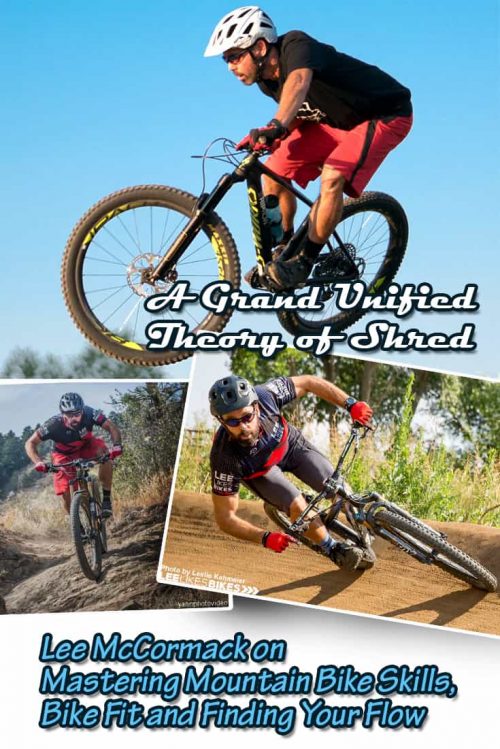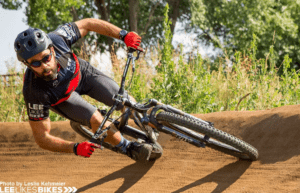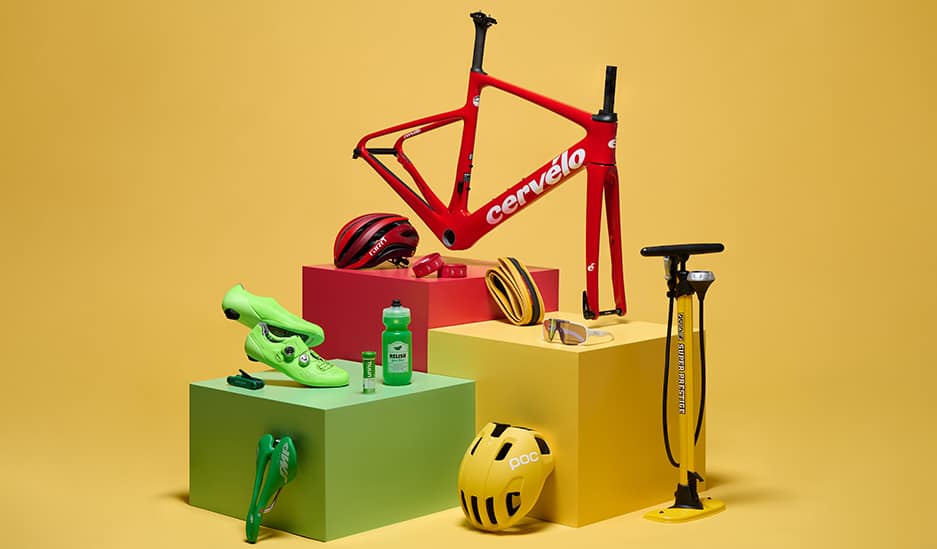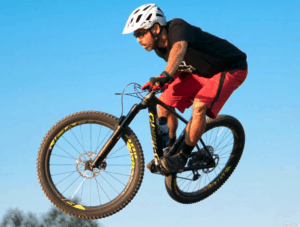- Shimano 105 vs Tiagra: Should You Upgrade? - January 6, 2020
- The Best Mountain Bike Grips for the Money + Complete Buying Guide - November 4, 2018
- The Best MTB Handlebars For Every Bike + Buying Guide - November 4, 2018
When you ride your mountain bike with skill and confidence, time slows down. Your whole world becomes the few feet of trail in front of you and you just flow. There’s nothing like it.
More time in the saddle only takes you so far in this pursuit, which is where learning from a teacher like Lee McCormack comes in. His book Mastering Mountain Bike Skills, classes, and “Lee Likes Bikes” online school exist for those who want to achieve the kung-fu bike skills that lead to this transcendent experience
I joined the Lee Likes Bikes online school to get a taste of Lee’s teaching style and then caught up with the mtb guru later to hear his take on everything from his research to the state of the bicycle industry and how he balances family life with his unconventional career. Not everyone agrees with his methods, but he stands by them as the best advice available.
The Genesis of Lee McCormack
“I’ve been on bikes for 30 years. I started off loving it and sucking at it. I still love it and suck a little less,” Lee says. He started his career as a newspaper graphics designer, where he once won a Pulitzer Prize for community service. A self-described “fat kid” with a driven ego, he raced downhill as a semi-professional competitor from 1992 to 2004 and represented team USA at a world championship.
With enough riding success to satisfy him, he then pivoted his career to coaching and writing. “I have a basic compulsion to figure things out and make them simple and beautiful.” Lee says. “I feel like this is my purpose.”
Lee is now a full-time author and instructor in Colorado, known as an authority on shredding a mountain bike. His best-selling 2005 book, Mastering Mountain Bike Skills is now in its third edition and he’s authored 10 books on related topics, including Dialed, his most recent book that takes a deep dive into bike fit. He’s taught instructional classes for over 6,000 students and maintains a small empire of online instruction communities.
Learn More About Lee :
Online School
Lee’s website, Leelikebikes is his career’s worth of teaching materials, including videos, interactive bike fit calculators, a vibrant interactive comments section, and a Facebook group. Some of the material is available pro bono, but the really juicy stuff requires a paid membership.
Lee’s online instruction takes a three-pronged approach: bike fit, riding skills, and fitness/ training. The idea is that riders should start with a bike set up to their unique body, then develop a mind/body connection to develop their riding skills and add strength training. The result is an all-encompassing, self-guided course that has the potential to make your riding more safe, confident and fun.
Monthly membership is $19 and a yearly membership is $199. I found this fee to be money well-spent, as I learned more about riding in one month of reading than my previous decade of mountain biking.
Bike Skills
The skills section is packed with advice and techniques to conquer any terrain with speed and grace. Lee teaches “rowing” the bike up the front and “anti-rowing” the backside of each trail feature. Riders who master the row/anti-row can apply the technique to any rock, roller and root on the trail.
Instruction is broken down into sections, including braking, cornering, jumping, dropping, and general “kung-fu master” bike handling. Video clips, photo sequences and easy-to-follow prose explain the concepts nicely.
Bike Fit
There are loads of “bike fit” theories, none of which are agreed upon as dogma, though these theories’ devotees treat them as gospel. Lee eschews the conventional static method of fitting for a more dynamic fit based on his experience fitting over 6,000 riders.
Lee’s radical “RideLogic” approach to fitting results in a measurement known as “Rider Area Distance,” – RAD – which Lee describes a “sacred.” RAD optimizes the geometrical relationship between the rider’s hands and feet to maximize range of motion. “Your bike’s RAD number has a huge effect on how your bike fits. It should match your body,” Lee says.
Subscribers can use the online body measurement calculators to achieve a RAD fit on their existing bike, or pick the appropriate frame size and components to buy a bike that will fit them well. Pursuing a RAD fit will sometimes result in picking a modern bike that is a size smaller than what the manufacturer recommends.
Lee on Modern Mountain Bike Geometry
“Bikes are getting longer. People are not getting bigger.” Lee says. “For many of us, we need to go down a size or use our old size with a very short stem and bars with extra setback [horizontal backward reach on handlebar].If you can’t go smaller on frame, you need to pick another model or get your bars as close and low as you can.”
“I meet a lot of people who buy a new bike based on bike shop recommendations or sizing charts who are on the wrong size bike. And it’s almost always too big,” Lee says. “Most people who need to take pains to clear thousands of dollars to buy a new bike should end up with something that fits, but many don’t.”
“It’s crazy. I don’t know what the bike industry is doing,” Lee says. “This is an opinion, but I think there’s a mix of tradition, ignorance, and ideas from smart people that I don’t happen to agree with.”
He says that limited body mobility and stability on downhills inspires long bikes, but making it to the bottom of a hill upright should not be the only metric by which to measure a frame design. “You might have fun, but it won’t feel amazing,” he says.
My Experience
My current bike was set up quite a bit larger than Lee’s RAD fit, so I replaced my stem with a shorter one and replaced my handlebar with a wider, more swept-back model to get my RAD within one centimeter of Lee’s calculator. Doing so contradicted advice of a wave of outside advice.
The result is a bike that does feel a bit easier to wrangle and does not yet feel cramped. Getting my handlebar lower and closer to me encourages me to get off the saddle and whip the bike around more, not just sit and mash like I had in the past. Time will tell if this works, but I doubt I’ll go back any time soon.
Find great deals on specialty bike components including wheels, tires, brakes, cables, forks, pedals, and more. Competitive Cyclist is your shop for everything.
Lee on Shredding
Lee says that the method he teaches is applicable to everyday life, a kind of Grand Unified Theory of Shred.
“People have no idea what it means to achieve Flow with a capital F – what it means to have such mastery of your body and your bicycle that you can transcend your consciousness and just live this insanely productive life. Bikes are one way to do it, playing trumpet another way… there are lots of ways,” he says.
Lee on Fear
“I thought that people who could jump were at a higher level of badass. The people who I rode with who could jump has some magic, some sort of flair, or freedom from anxiety that I didn’t have. I felt a compulsion to learn how to jump, but I had no idea what the mechanics of jumping were.”
Lee describes his motivation as unhealthy, even pathological. “The whole path from wounded, fat little kid who needs to prove something to himself and to the world, to rider who enjoys it… I had to go through the path to get it.”
“Fear is a signal from your body that something is wrong. Very few people know the difference between ‘my body is aroused and ready to execute’, and ‘I’m afraid.’ That is a hugely important distinction,” Lee warns. “If you’re afraid with uncontrollable tension, that’s the lizard in your brain saying ‘Dude’! Not cool!’ I never, ever push through that. Fear is a signal that something is amiss and you need to heed that.”
“My special combination of willingness to tolerate psychic pain, eagerness to create exertion pain, and willingness to tolerate physical damage pain… I really fucked myself up,” Lee says.
“You have the pain of exertion, and the pain of structural damage is a different kind of pain that you need to know.” Many people, especially men, don’t know how to listen to their bodies and suffer injury as a result of pushing through an injury rather than treat it. “They don’t know what the signals in their bodies are,” Lee says.
Practicing Skills
To surpass fear and enter a state of flow, you have to “… give yourself the level of mastery to where you feel ready and excited, but not afraid,” Lee explains. Like learning to “wax-on, wax off”, Lee stresses “creating the neurological patterns to act. If you don’t have that, your lizard brain will make you do irrational things that seem rational: grab the brakes, freeze over a jump, shift weight the wrong direction.”
“If you’re a basketball player, you don’t play full-court basketball every day. You do drills,” Lee says. Becoming a father limited Lee’s time on the bike, forcing him to use small amounts of down time to focus on specific skills like pedaling and cornering in the form of drills. He says this is the key to mastering specific skills.
“You have to focus on something, and you have to iterate and iterate, repeat and repeat with some self-awareness,” he says. Isolating a specific skill while riding a trail involves too many mental distractions. To achieve the needed focus, ride bike parks, repeat a small loop several times, or practice skills in a parking lot.
“If you just go and ride, you will get better at going and riding. Whatever patterns you have are just going to get burned-in. If you have a natural talent, then you will remain naturally talented. If you don’t have a natural talent, you might get stronger and you might get less afraid because you have confidence in your bike, but you’re not going to get better. You should practice.”
Beyond that, you have to time when you are going to apply that skill to a challenge, when the skill has been sufficiently mastered, and when your body is strong enough to pull it off. Then you need to have the right arousal level. Your mind and body need to be somewhere between bored and nervous. An arousal level of eight out of 10 is optimal.
“If you can do all those things, and you’re not afraid, it’s game on,” Lee says.
Lee on Strength Training
The third prong in Lee’s approach to teaching is fitness. Lee’s program includes several books about strength training in the gym to improve your riding. Following it should make you more skilled at moving and stabilizing the bike and less prone to injury.
“People don’t move well,” Lee says of the biggest struggle he sees among students. “One percent of riders have a good ‘hinge.’ If you don’t hinge well [ability to bend at the hips with stability] and have body awareness, then riding is gonna be a lot of work uphill, and it’s just going to be this frenetic, exciting, kinda scary experience downhill. People don’t know how to move, and they don’t even know that there’s this whole other world available.”
Lee on the RipRow
“The essential movement patterns for riding is the same for every sport. There are certain ways that those body parts work together, and we plug that into the bike. So when you learn how to ride with me or with a RipRow, you’re learning how to be a linebacker, a climber, a kayaker, a furniture mover, a dad playing with his kids,” Lee says. “It’s an archetype.”
Lee invented the RipRow, a standalone piece of exercise equipment described as “the extreme bastard child of a rowing machine, a bench press, a squat rack, a balance board and a dead lift.” It looks like the front half of a fork-less mountain bike on a balance platform with two shocks to create fore-aft resistance. The idea is to mimic all the “row/ anti-row” motions used on a mountain, BMX, or MX bike. It works all of the muscles that make a rider strong and stable in one fluid workout, without actually getting on the trail.
The RipRow is Lee’s personal invention and he says he has demoed it with professional football players and other athletes in addition to scores of cyclists. He has rigged a power meter to a RipRow and monitored the progress of athletes who use it with positive results. Customers can buy a personal RipRow (www.riprow.com) for $1,000 and he hopes it will be available in gyms eventually.
Future of LLB
Lee’s tenth upcoming book is close to finished at this time. “Dialed” will be a print, PDF, and online book that “expresses the RideLogic fit system. The philosophy that I have that’s tied to movement patterns and fitting a bicycle so that you can ride dynamically.” It will include basics like picking a new bike with the right frame size and setting up a bike for a specific riding style.
In addition to revamping the LLB school website and peddling the RipRow, Lee continues to teach clinics and interact with his online school community. His busy schedule as a teacher, author, inventor, businessman, and dad sounds like five full-time jobs. But, knowing Lee, I’m sure he’s got energy to spare.
* Readers can save $5 on Dialed by using the code CHDIALED5 at checkout
Find great deals on specialty bike components including wheels, tires, brakes, cables, forks, pedals, and more. Competitive Cyclist is your shop for everything.




